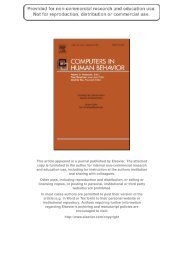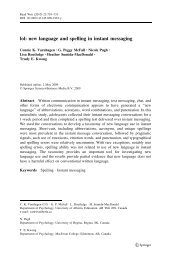Six Models for the Internet + Politics
You also want an ePaper? Increase the reach of your titles
YUMPU automatically turns print PDFs into web optimized ePapers that Google loves.
36 <strong>Six</strong> <strong>Models</strong> <strong>for</strong> <strong>the</strong> <strong>Internet</strong> + <strong>Politics</strong><br />
direct engagement of citizens in producing a range of public goods and acting<br />
<strong>for</strong> <strong>the</strong>mselves. According to <strong>the</strong> “Here Comes Everybody” view, citizens who<br />
organize <strong>the</strong>mselves through ICTs can accomplish many tasks more effectively,<br />
efficiently, and quickly compared with traditional hierarchical organizations.<br />
As Model 6 below shows, digitally enabled self-organization can be an impactful<br />
tool <strong>for</strong> constituent mobilization, particularly in times of political emergency<br />
or crisis. However, digitally enabled self-help is less likely to be effective <strong>for</strong> continuous<br />
collective action and commitment in times of political normalcy. There<br />
are at least three reasons <strong>for</strong> this.<br />
First, effective public action in most domains requires inputs—money, authority,<br />
capacity—that self-organized individuals frequently lack. The <strong>Internet</strong> may be<br />
able to help individuals organize neighborhood watch patrols, park cleanups,<br />
wiring schools <strong>for</strong> <strong>Internet</strong> access, and o<strong>the</strong>r modern <strong>for</strong>ms of barn-raising. Most<br />
of those tasks, however, would be more ably accomplished if concerned individuals<br />
could call upon <strong>the</strong> resources and capacities of existing infrastructure such as<br />
local police departments, parks services, and school systems. There is a world of<br />
difference, <strong>for</strong> example, between <strong>the</strong> initial vision of an organization like See-<br />
ClickFix, which developed software that allows individuals to report and visualize<br />
local problems like dangerous intersections and potholes and projects like <strong>the</strong><br />
British FixMyStreet and Boston CitizensConnect, which use ICTs not just <strong>for</strong> citizen<br />
reporting and visualization, but also connect those reports to <strong>the</strong> appropriate<br />
city service agencies. 12 A participant at one recent technology and policy<br />
conference put it this way: “I see, ‘See-Click-Fix’ without government is only<br />
‘See-Click.’”<br />
A second difficulty is that <strong>the</strong> “Here Comes Everybody” approach as a method<br />
of solving public problems and providing public goods is likely to be plagued by<br />
free rider problems. 13 Small groups of individuals may be able to satisfy <strong>the</strong>ir<br />
own interests. But because of <strong>the</strong> motivational issues, even civically minded selfhelp<br />
groups will “under-produce” public goods because many people will free<br />
ride-off of <strong>the</strong>ir ef<strong>for</strong>ts. For any <strong>Internet</strong>-organized park cleanup, <strong>the</strong>re will be<br />
many more people who benefit from <strong>the</strong> clean park than people who participate<br />
in cleaning it up. One thing that government does—and what <strong>the</strong> self-help<br />
model by definition cannot do—is tax those o<strong>the</strong>r park users to pay <strong>for</strong> an<br />
appropriate level of clean-up.<br />
A third difficulty is that self-organized production over digital channels has<br />
been most effective when <strong>the</strong> things being produced consist mostly of in<strong>for</strong>mation,<br />
and <strong>the</strong> production process involves <strong>the</strong> manipulation of in<strong>for</strong>mation. Wikipedia,<br />
LINUX, SETI, and so on are projects in which digital engagement<br />
produces digital products. Many public goods, however, do not consist primarily<br />
of in<strong>for</strong>mation, but of bricks-and-mortar and human interactions (education,<br />
policing, social service work). While ICTs can contribute to <strong>the</strong> production of<br />
such public goods through coordination and in<strong>for</strong>mation sharing, its impact is<br />
likely to be less profound than when <strong>the</strong> things being produced are essentially<br />
in<strong>for</strong>mational (e.g., encyclopedias, software).<br />
For <strong>the</strong>se three reasons, we think digitally facilitated self-help is an interesting<br />
phenomenon and that <strong>the</strong>re will be many important examples that fill gaps in<br />
public services and public action. However, this dynamic will be limited, and it is<br />
unlikely to displace <strong>the</strong> role of traditional public agencies and civic organizations<br />
12 For more in<strong>for</strong>mation visit SeeClickFix: http://seeclickfix.com/,; FixMyStreet: http://www.fixmystreet.com/;<br />
and Boston CitizensConnect: http://www.cityofboston.gov/doit/apps/citizensconnect.asp. SeeClickFix has evolved<br />
now so that it does not just provide <strong>the</strong> reporting and visualization plat<strong>for</strong>m, but works with a number of city governments<br />
to tie those plat<strong>for</strong>ms to <strong>the</strong> appropriate city agencies.<br />
13 Shirky (p. 52–3) acknowledges that “In <strong>the</strong> current spread of social tools, real examples of collective action—<br />
where a group acts on behalf of, and with shared consequences <strong>for</strong>, all of its members—are still relatively rare.”
















